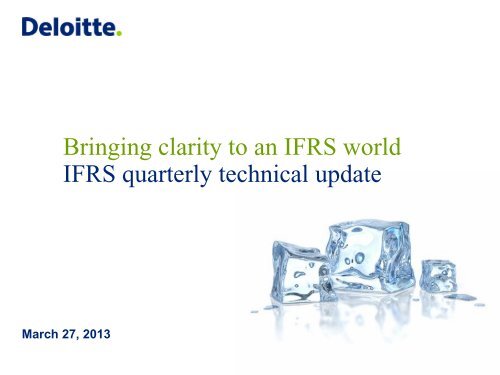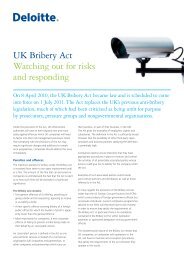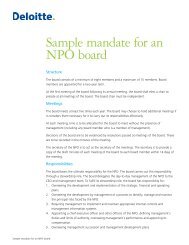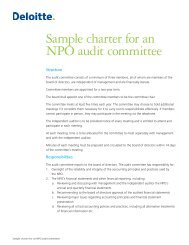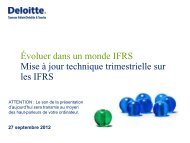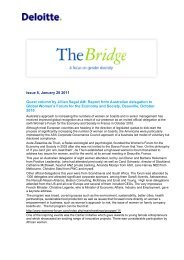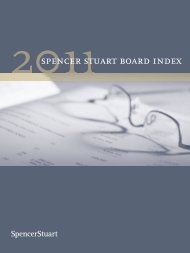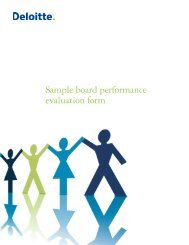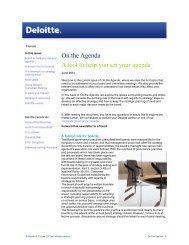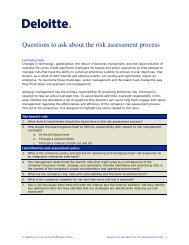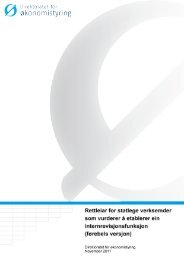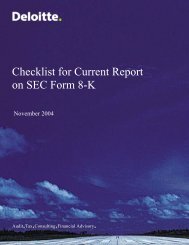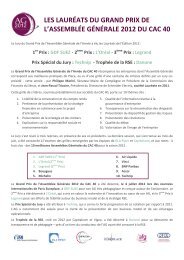Download the presentation slides - Deloitte
Download the presentation slides - Deloitte
Download the presentation slides - Deloitte
Create successful ePaper yourself
Turn your PDF publications into a flip-book with our unique Google optimized e-Paper software.
Bringing clarity to an IFRS worldIFRS quarterly technical updateMarch 27, 2013
Agenda• Q1 considerations• Disclosure principles to consider when adopting new standards• Key reminders for Q1:– IFRS 10 Consolidated Financial Statements– IFRS 11 Joint Arrangements– IFRS 13 Fair Value Measurement– IFRIC 20 Stripping Costs in <strong>the</strong> Production Phase of a Surface Mine– IAS 19 (2011) Employee Benefits• IASB and IFRS Interpretations Committee (IFRIC) Update1 Bringing clarity to an IFRS world | IFRS quarterly technical update© <strong>Deloitte</strong> LLP and affiliated entities.
Q1 considerations oninitial adoption of newIFRS standards2 Bringing clarity to an IFRS world | IFRS quarterly technical update© <strong>Deloitte</strong> LLP and affiliated entities.
New IFRS standards impacting Q1• Effective for annual periods beginning on or after January 1, 2013:IFRS 7 Financial Instruments: Disclosures –amendmentsIFRS 10 Consolidated Financial StatementsIFRS 11 Joint ArrangementsIFRS 12 Disclosure of Interests in O<strong>the</strong>r EntitiesIFRS 13 Fair Value MeasurementIAS 1 Presentation of Financial Statements –amendments**IAS 19 (2011) Employee BenefitsIAS 28 Investments in AssociatesIFRIC 20 Stripping Costs in <strong>the</strong> Production Phase ofa Surface MineAre youprepared?** effective for annual periods beginning on or after July 1, 20123 Bringing clarity to an IFRS world | IFRS quarterly technical update© <strong>Deloitte</strong> LLP and affiliated entities.
Changes to IAS 1 impacting <strong>presentation</strong> of OCI• OCI balances now have to be grouped into two groups:– those which may be recycled into profit and loss (e.g. cash flow hedges, AFS securities,CTA); and– those which will not be recycled into profit or loss (e.g. IAS 19re-measurements, IAS 16 revaluation gains)• If <strong>the</strong>se amounts are presented gross and <strong>the</strong> tax effects are separatelydisclosed, <strong>the</strong> tax impacts have to also be similarly grouped into <strong>the</strong> twocategories.• See example on next slide4 Bringing clarity to an IFRS world | IFRS quarterly technical update© <strong>Deloitte</strong> LLP and affiliated entities.
Sample <strong>presentation</strong> of OCI as required by amendmentsto IAS 1Current year Prior year$'000's $'000'sProfits for <strong>the</strong> period 143,480 115,600O<strong>the</strong>r comprehensive incomeItems that will not be reclassified to profit or lossActuarial gains/(losses) on defined benefit plans 10,000 (20,000)Income tax relating to items not reclassified (3,200) 6,400Total items that will not be reclassified to profit or loss 6,800 (13,600)Items that may be reclassified subsquently to profit or loss:Cash flow hedges- Gains/(losses) arising during <strong>the</strong> period 12,000 (16,000)- Reclassification adjustments for amounts recognised in profit or loss (2,000) 2,500Income tax relating to items that may be reclassified (3,200) 4,320Total items that may be reclassified subsequently to profit or loss 6,800 (9,180)O<strong>the</strong>r comprehensive income/(loss) for <strong>the</strong> period 13,600 (22,780)Total comprehensive income for <strong>the</strong> period 157,080 92,8205 Bringing clarity to an IFRS world | IFRS quarterly technical update© <strong>Deloitte</strong> LLP and affiliated entities.
Additional new disclosures required under IFRS 7• New disclosures are required about rights of offset and related arrangements• Transactions impacted include collateral posting requirements and all masternetting arrangements whe<strong>the</strong>r or not <strong>the</strong> criteria for balance sheet offset aremet.• Separate disclosure for financial assets and financial liabilities is required –generally in tabular format• Key disclosures include:a) Gross amounts subject to agreementsb) Amounts shown net in balance sheetc) Net Subtotal of (a) minus (b)d) Amounts subject to offset or master netting agreements not presented nete) Net subtotal of (c) minus (d)Alert: There is some uncertainty about <strong>the</strong> specific interim f/s which require <strong>the</strong>sedisclosures based on <strong>the</strong> March 2013 IFRIC discussions. Consultation with your auditoris recommended.6 Bringing clarity to an IFRS world | IFRS quarterly technical update© <strong>Deloitte</strong> LLP and affiliated entities.
Specific new disclosures required by IFRS 7• Assume an entity has <strong>the</strong> following financial assets and financial liabilities:– Derivative assets and derivative liabilities that are subject to a master nettingarrangement by counterparty in <strong>the</strong> event of default. No balance sheet offsetting.Counterparty A Counterparty B TotalDerivative assets $400,000 $250,000 $650,000Derivative liabilities ($800,000) ($350,000) ($1,150,000)Cash collateral ondeposit- $100,000 $100,000Financial AssetsFinancialLiabilities(a) Gross amounts subject to agreements $ 650,000 $1,150,000(b) Amounts shown net in balance sheet - –(c) Net Subtotal of (a) minus (b) 650,000 1,150,000(d) Amounts subject to master netting agreementsbut not presented netSubject to AgreementsCash collateral(650,000) (650,000)(100,000)(e) Net subtotal of (c) minus (d) $ – $ 400,0007 Bringing clarity to an IFRS world | IFRS quarterly technical update© <strong>Deloitte</strong> LLP and affiliated entities.
Specific new disclosures required by IFRS 7 (cont.)• Agreements to look out for include (but are not limited to):– Derivative agreements such as ISDA agreements– Securities lending and borrowing– Repurchase and reverse repurchase agreements– Margin account agreements– Collateral received and pledged8 Bringing clarity to an IFRS world | IFRS quarterly technical update© <strong>Deloitte</strong> LLP and affiliated entities.
General disclosureprinciples to considerwhen new standardsare adopted9 Bringing clarity to an IFRS world | IFRS quarterly technical update© <strong>Deloitte</strong> LLP and affiliated entities.
General disclosure principles to consider when newstandards are adoptedIAS 8 – guidance on disclosures for <strong>the</strong> initial application of IFRS– <strong>the</strong> most significant are IAS 8.28(f) – (h)• Amount of adjustment for each line item affected• Amount of adjustment on basic and diluted earnings per share• Amount of adjustment relating to periods before those presentedIAS 34 – general requirements to provide disclosure of significant transactions andevents– refer to IAS 34.15C and IAS 34.16A (a) and (i)• If event or transaction is significant to understanding <strong>the</strong> changes in financial positionor performance since <strong>the</strong> last annual reporting period, provide explanation of and anupdate to <strong>the</strong> relevant information• Describe <strong>the</strong> nature and effect of changes in accounting policies or methods• Disclose effect of changes in <strong>the</strong> composition of <strong>the</strong> entity10 Bringing clarity to an IFRS world | IFRS quarterly technical update© <strong>Deloitte</strong> LLP and affiliated entities.
Interim disclosure considerationsNew or amended accounting policiesNew critical accounting judgments and estimation uncertaintyChange in disclosure of balances relating to adoption of new or amendedstandards (e.g. Goodwill recognized for newly consolidated sub)Update notes to reflect changes in accounting policiesNew commitments, contingencies, risks, and uncertainties11 Bringing clarity to an IFRS world | IFRS quarterly technical update© <strong>Deloitte</strong> LLP and affiliated entities.
When to include a third balance sheet• Required in condensed or complete interim financial statements at <strong>the</strong> start of<strong>the</strong> earliest comparative period under Part 4.3(2)d of National Instrument 51-102 Continuous Disclosure Obligations if, during <strong>the</strong> period:– Reclassification of a financial statement item– Adoption a new accounting standard; or– Change an accounting policy• A third balance sheet is a securities requirement and not an option whenchanges triggering consideration for a third balance sheet are material.Recommendation: include <strong>the</strong> third balance sheet when <strong>the</strong> criteriaunder NI 51-102 are met*IAS 1 only addresses annual financial statements12 Bringing clarity to an IFRS world | IFRS quarterly technical update© <strong>Deloitte</strong> LLP and affiliated entities.
When to include a third balance sheet (cont.)Facts:• Entity A previously accounted for a significant joint arrangement using <strong>the</strong> equity method. Upon adoptionof IFRS 11, <strong>the</strong> entity concluded that <strong>the</strong> arrangement met <strong>the</strong> definition of a joint venture and is stillaccounted for using <strong>the</strong> equity method. There was no o<strong>the</strong>r impact from any o<strong>the</strong>r new standards.• Entity B has <strong>the</strong> same facts as entity A, except it was concluded that <strong>the</strong> arrangement was a jointoperation under IFRS 11 so <strong>the</strong> basis of accounting was changed upon adoption of IFRS 11• Which entity would be more likely to include a third balance sheet?Example of items to consider: Entity A Entity BJoint VentureJoint OperationAre adjustments quantitatively material? No It dependsAre adjustments qualitatively material? No It dependsAdjustment to any line items on <strong>the</strong> statement offinancial position?Is <strong>the</strong>re an impact on covenants or keyperformance indicatorsNoNoYesIt depends, but likely.Will <strong>the</strong>re be an impact on subtotals? No YesAre adjustments pervasive? Do <strong>the</strong>y impact manyline items on <strong>the</strong> statement of financial position?NoIt depends, but likely.O<strong>the</strong>r It depends It depends13 Bringing clarity to an IFRS world | IFRS quarterly technical update© <strong>Deloitte</strong> LLP and affiliated entities.
IFRS 10Consolidated FinancialStatements14 Bringing clarity to an IFRS world | IFRS quarterly technical update© <strong>Deloitte</strong> LLP and affiliated entities.
The control model – SummaryControl =PowerExposure/ right+ to variable +returnsAbility to usepower to affectamount of returns= Substantive rightsthat give investorcurrent ability todirect “relevantactivities” 1 .= Returns that varywith investeeperformance (only +,only -, or both). Nothreshold onvariability.Requires analysis of:• Investor as principalvs. agent• Delegated authorityRights include: Voting rights Potential votingrights Contractual rights Protective rightsReturns include: Dividends Changes in valueof investment Synergisticbenefits1) “Relevant activities” are those that significantly affect <strong>the</strong> returns of <strong>the</strong> investee.15 Bringing clarity to an IFRS world | IFRS quarterly technical update© <strong>Deloitte</strong> LLP and affiliated entities.
Quick Hits: What you need to know about IFRS 10…• Areas of complexity:− The assessment of de facto power− Consideration of potential voting rights− Determining exposure to variable returns− Principal vs. agent issues• Need to exercise professional judgment appropriately to determine whe<strong>the</strong>ran entity should be consolidated or deconsolidated• Critical assessment of whe<strong>the</strong>r <strong>the</strong> transition provisions of IFRS 10 have beenproperly applied16 Bringing clarity to an IFRS world | IFRS quarterly technical update© <strong>Deloitte</strong> LLP and affiliated entities.
De facto powerPower may exist when an investor holds < 50% of <strong>the</strong> votingrights• What to consider . . .– Size and dispersion of o<strong>the</strong>r investors’ voting rights– Potential voting rights held by investor, o<strong>the</strong>r vote holders or o<strong>the</strong>r parties– Rights arising from o<strong>the</strong>r contractual arrangements• Impact– Consolidation required if control is achieved– Impacts judgements policy note – describe why control was determined eventhough <strong>the</strong> investor holds
Potential voting rightsPotential voting rights may impact <strong>the</strong> control assessment• What to consider . . .– Voting rights do not have to be currently exercisable but consideration ofvalue (in/out/at-<strong>the</strong>-money, synergistic benefits, etc) is required.– Examples include:• Warrants• Convertible debt• Purchased options to acquire voting interests• Forward contracts for voting interests– Look at shareholders agreements and standalone rights in o<strong>the</strong>r contracts– Consideration of rights in o<strong>the</strong>r contracts to determine if <strong>the</strong>y are protective orparticipating18 Bringing clarity to an IFRS world | IFRS quarterly technical update© <strong>Deloitte</strong> LLP and affiliated entities.
Q1 Transition Considerations• Retrospective application:– The level of effort could be significant:• Information available• Complexity of operation• Passage of time from <strong>the</strong> date of control to transition date• Limited exceptions – refer to IFRS 10.C3 – C6• Cumulative adjustment through <strong>the</strong> balance sheet and opening retainedearnings as of January 1, 2012• Comparative information for all periods presented will require restatement• Consequential amendments to footnotes for all periods presented may alsobe required19 Bringing clarity to an IFRS world | IFRS quarterly technical update© <strong>Deloitte</strong> LLP and affiliated entities.
Q1 Disclosure Considerations• Disclosures previously discussed pursuant to IAS 8 and IAS 34• IFRS 12– O<strong>the</strong>r IFRS 12 disclosures are annual disclosure requirements and thus arevoluntary in Q1– An entity should apply judgment on what annual disclosures should be included in Q1• Judgment will depend on whe<strong>the</strong>r <strong>the</strong>re is a material impact to <strong>the</strong> financialstatements arising from adoption of <strong>the</strong> new standards and <strong>the</strong> event ortransaction is significant to <strong>the</strong> understanding of <strong>the</strong> changes in <strong>the</strong> entity’sfinancial position or performance since <strong>the</strong> last annual reporting period [IAS34.15C]20 Bringing clarity to an IFRS world | IFRS quarterly technical update© <strong>Deloitte</strong> LLP and affiliated entities.
Example – Consolidation of previously unconsolidatedentityFacts:• Entity A has a 48% ownership in Entity C and was accounted for using <strong>the</strong> equity methodof accounting.• On adoption of IFRS 10 on January 1, 2013, management concluded that A has controlover C since its acquisition in June 2009 on <strong>the</strong> basis of A’s absolute size of holding in Cand <strong>the</strong> relative size of and dispersion of <strong>the</strong> shareholdings owned by <strong>the</strong> o<strong>the</strong>rshareholders. Therefore under IFRS 10, C has been a subsidiary of A since June 2009.• The impact is material to all periods presentedQ1 disclosure considerations:• IAS 8:– Reconciliations of profit & loss for <strong>the</strong> 3 months ended March 31, 2013 and 2012; and– Reconciliation of net assets and equity as at January 1, 2012, March 31, 2013 andDecember 31, 2012• IAS 1 and CSA NI 51-102:– Opening balance sheet– Amend accounting policy for basis of consolidation and assess o<strong>the</strong>r footnotedisclosures– Impact on critical judgements21 Bringing clarity to an IFRS world | IFRS quarterly technical update© <strong>Deloitte</strong> LLP and affiliated entities.
IFRS 11Joint Arrangements22 Bringing clarity to an IFRS world | IFRS quarterly technical update© <strong>Deloitte</strong> LLP and affiliated entities.
Quick Hits: What you need to know about IFRS 11…There are many areas of complexityIdentifying whe<strong>the</strong>rjoint control exists• No single party should be able to act unilaterally at anypoint of time to control <strong>the</strong> activity when joint controlexists• Potential voting rights and rules around casting votesIdentifying whe<strong>the</strong>r ajoint arrangement is ajoint venture or jointoperationComplex• Many forms and structures• Use of a separate vehicle can make <strong>the</strong> determinationof <strong>the</strong> type of <strong>the</strong> joint arrangement more difficult• Underlying rights and obligations of <strong>the</strong> parties in <strong>the</strong>context of contractual arrangement and o<strong>the</strong>r facts andcircumstancesTransition from IAS 31to IFRS 11• All joint arrangements should be reassessed23 Bringing clarity to an IFRS world | IFRS quarterly technical update© <strong>Deloitte</strong> LLP and affiliated entities.23
Key accounting implications• Joint arrangements are ei<strong>the</strong>r joint operations or joint ventures. There is nolonger an accounting policy choiceJoint ventureJoint operationEquity methodShare of rights to assets and obligations forliabilities, revenues and expenses recorded• Many joint arrangements operated through a separate legal vehicle previouslyaccounted for under <strong>the</strong> proportionate consolidation method will now beconsidered to be joint ventures and thus be accounted for using <strong>the</strong> equitymethod24 Bringing clarity to an IFRS world | IFRS quarterly technical update© <strong>Deloitte</strong> LLP and affiliated entities.
Key accounting implications – Joint venture versus jointoperationStep 1Is <strong>the</strong> arrangement conducted through aseparate vehicle?NoYesStep 2Does legal form of <strong>the</strong> vehicle give partiesrights to assets and obligations for liabilities?YesStep 3Do terms of <strong>the</strong> contractual arrangementgive parties rights to assets and obligation forliabilities?NoYesJointoperationStep 4NoO<strong>the</strong>r facts and circumstances – is <strong>the</strong>design of <strong>the</strong> arrangement such that partiesin effect have rights to assets and obligationsfor liabilities?YesNoJoint venture25 Bringing clarity to an IFRS world | IFRS quarterly technical update© <strong>Deloitte</strong> LLP and affiliated entities.
Q1 Transition Considerations• Modified Retrospective application• Proportionate consolidation to equity method: apply at beginning of earliestperiod presented (January 1, 2012) IFRS 11.C2 – C5• Equity method to accounting for share of assets and liabilities: modifiedretrospective treatment applied at beginning of earliest date presented (January1, 2012) IFRS 11.C7-C9• Comparative information for all periods presented will require restatement• Consequential amendments to footnotes for all periods presented may alsobe required26 Bringing clarity to an IFRS world | IFRS quarterly technical update© <strong>Deloitte</strong> LLP and affiliated entities.
Q1 Disclosure Considerations• Disclosure requirements are in both IFRS 11 and IFRS 12. Also consider thosedisclosures previously discussed pursuant to IAS 8 and IAS 34.• IFRS 11– IFRS 11.C5 requires specific disclosure of <strong>the</strong> aggregate breakdown of all assets andliabilities aggregated into equity method investments when transitioning fromproportionate consolidation to equity method– IFRS 11.C10 requires a reconciliation between <strong>the</strong> equity investment derecognized,and <strong>the</strong> assets and liabilities recognized, toge<strong>the</strong>r with any remaining differenceadjusted against retained earnings.• IFRS 12– O<strong>the</strong>r IFRS 12 disclosures are annual disclosure requirements and thus arevoluntary in Q1– An entity should apply judgment on what annual disclosures should be included in Q127 Bringing clarity to an IFRS world | IFRS quarterly technical update© <strong>Deloitte</strong> LLP and affiliated entities.
Proportionate consolidation to equity methodFacts:• Entity A has a 50% ownership in JV Electronics Limited and was accounted for using <strong>the</strong>proportionate consolidation method.• Under IFRS 11, JV Electronics Limited is determined to be a joint venture and <strong>the</strong>company’s interest in JV Electronics is required to be accounted for using <strong>the</strong> equitymethod.What journal entries would need to be made?Dr. Proportionately consolidated liabilitiesDr. New value for Equity Investment (Note 1)Cr. Proportionately consolidated assets (Note 2)Note 1 – The value of <strong>the</strong> new equity method investment is <strong>the</strong> aggregate of <strong>the</strong> carryingamounts derecognized by ceasing proportionate consolidation. An initial assessment ofimpairment is required at date of transition. Special guidance for negative net assets.Note 2 – Need to ensure that fair value bumps are included in <strong>the</strong> assets and liabilitiesbeing recognized and that goodwill is allocated to <strong>the</strong> asset group being derecognized, ifappropriate.28 Bringing clarity to an IFRS world | IFRS quarterly technical update© <strong>Deloitte</strong> LLP and affiliated entities.
Example – Proportionate consolidation to equity method(cont.)Annual IFRS 12 disclosures for consideration in Q1 (cont.)For each materialJoint operationJoint ventureName of subsidiary, joint arrangement or associate Nature of relationship Principal place of business and, if different, country ofincorporationProportion of ownership and, if different, voting rights held Method of accounting (equity method or fair value)Fair value, if equity method is used and investee is quotedUnrecognized losses for equity method investmentsRestrictions on access to an investee’s assetsDifferent reporting date of investor and investeeCommitmentsContingent liabilities= New requirement in IFRS 12; not in IAS 27, IAS 28, IAS 31.= Expanded requirement in IFRS 12 as compared with IAS 27, IAS 28, IAS 31.29 Bringing clarity to an IFRS world | IFRS quarterly technical update© <strong>Deloitte</strong> LLP and affiliated entities.
IFRS 13Fair Value Measurement30 Bringing clarity to an IFRS world | IFRS quarterly technical update© <strong>Deloitte</strong> LLP and affiliated entities.
Scope of IFRS 13This is not just a Financial Instrument standard!IFRS 3 IAS 18IAS 38IFRS 5 IAS 32IAS 40IAS 16IAS 36IAS 41* This is not an exhaustive list. O<strong>the</strong>r standards and interpretations are impacted by IFRS 13.31 Bringing clarity to an IFRS world | IFRS quarterly technical update© <strong>Deloitte</strong> LLP and affiliated entities.
Disclosures: Key principlesEntities should disclose information that helpsusers assess <strong>the</strong> following:• Assets and liabilities measured at fair valueon a recurring basis after initial recognition• Assets and liabilities measured at fair valueon a non-recurring basis after initialrecognition32 Bringing clarity to an IFRS world | IFRS quarterly technical update© <strong>Deloitte</strong> LLP and affiliated entities.
Recurring vs. Non-recurring basisFocus on situations in which assets and liabilities are measured atfair value after initial recognition.Recurring basisRecurring fair value measurements of assetsor liabilities are those that o<strong>the</strong>r IFRSs requireor permit in <strong>the</strong> statement of financial positionat <strong>the</strong> end of each reporting periodExamples• Investment properties measured using <strong>the</strong>fair value model under IAS 40• Financial assets at fair value through profitor loss (e.g., held-for-trading investments)under IAS 39/IFRS 9• Available-for-sale investments under IAS 39• Property, plant and equipment/intangibleassets measured using <strong>the</strong> revaluationmodel under IAS 16/IAS 38• Biological assets under IAS 41Non-recurring basisNon-recurring fair value measurementsof assets or liabilities are those thato<strong>the</strong>r IFRSs require or permit in <strong>the</strong>statement of financial position inparticular circumstancesExamples• Assets classified as held for salemeasured at <strong>the</strong> lower of fair valueless costs to sell and <strong>the</strong>ir carryingamounts under IFRS 533 Bringing clarity to an IFRS world | IFRS quarterly technical update© <strong>Deloitte</strong> LLP and affiliated entities.
Key remindersHave you considered <strong>the</strong> following. . . .• Taken an inventory of all items affected?• Adjustments to valuation models?• Impact on purchase price allocations for business combinations that occurredduring <strong>the</strong> first interim period?• Determined <strong>the</strong> principal or most advantageous market?• Determined <strong>the</strong> highest and best use for non-financial assets?• Determined <strong>the</strong> most representative price within <strong>the</strong> bid-ask spread?• Fair value hierarchy applies to both financial and non-financial assets andliabilities.• Impact from <strong>the</strong> assumption that a liability is transferred to ano<strong>the</strong>r party ra<strong>the</strong>rthan extinguished or settled?• Impact from any asset-specific restrictions?• Is non-performance risk reflected in <strong>the</strong> fair value of liabilities?34 Bringing clarity to an IFRS world | IFRS quarterly technical update© <strong>Deloitte</strong> LLP and affiliated entities.
Q1 Transition Considerations• Prospective application required from January 1, 2013No adjustments to prior periods presented or retained earnings• Cumulative impact on existing balances are reflected through P&L or OCI,in <strong>the</strong> same manner as all o<strong>the</strong>r fair value adjustments relating to <strong>the</strong> item• Example:– A calendar year end entity adopts IFRS 13 effective January 1, 2013– The cumulative impact of any adjustments arising from changes to <strong>the</strong> method ofdetermining fair value to comply with IFRS 13 is recorded through P&L for all itemsmeasured at fair value through profit and loss or OCI for any items measured at fairvalue through OCI on January 1, 2013 and thus will impact net income/OCI for <strong>the</strong>three months ended Q1 2013.35 Bringing clarity to an IFRS world | IFRS quarterly technical update© <strong>Deloitte</strong> LLP and affiliated entities.
Q1 Disclosure Considerations• IAS 34.16A (j) includes <strong>the</strong> specific new disclosures required for financialinstruments to be included in interim financial statements:• IFRS 13. 91–93(h), 94–96, 98 and 99 (refer to Appendix A):– Fair value at reporting date and reason for fair value measurement (non-recurring only)– The level of <strong>the</strong> fair value measurement in <strong>the</strong> fair value hierarchy– Transfers between Levels 1 and 2, reasons for those transfers, and <strong>the</strong> entity's policyfor determining that a transfer has occurred– Description of <strong>the</strong> valuation techniques and inputs used for Level 2 and 3measurements and whe<strong>the</strong>r <strong>the</strong>re have been any changes– Level 3 only:• Quantitative information about significant unobservable inputs used• Reconciliation of movements in fair value from opening to closing balances• Description of <strong>the</strong> valuation processes used• Narrative description of <strong>the</strong> sensitivity of <strong>the</strong> fair value measurement to changes in unobservableinputsNote that <strong>the</strong> extensive IFRS 13 disclosures required for annual financial statements apply, in many cases, to both financial andnon-financial balances. For example, non-financial assets and liabilities will also have to be allocated to a Level 1, 2, or 3 fair valuehierarchy under IFRS 13 plus additional disclosures for Level 3 inputs and sensitivities for such items36 Bringing clarity to an IFRS world | IFRS quarterly technical update© <strong>Deloitte</strong> LLP and affiliated entities.
IFRIC 20 StrippingCosts in <strong>the</strong> ProductionPhase of a Surface Mine37 Bringing clarity to an IFRS world | IFRS quarterly technical update© <strong>Deloitte</strong> LLP and affiliated entities.
IFRIC 20 – Stripping Costs in <strong>the</strong> Production Phase of aSurface MineBackground:• Stripping – Removing waste to gain access to mineral ore deposits• In <strong>the</strong> development phase, stripping costs are capitalized as part of depreciablecost of <strong>the</strong> mine, and depreciated once production beginsHighlights:• Activity provides improved access to ore = stripping activity asset*– Addition to or enhancement of existing asset– Initially measured at cost– Subsequently carried at cost of revalued amount less depreciation and impairmentslosses• Activity is in form of inventory = account for in accordance with IAS 2* Certain criteria must be met to recognize a stripping activity asset:• Probable future economic benefits• Can identify component of <strong>the</strong> ore body which access has been improved• Costs can be measured reliably38 Bringing clarity to an IFRS world | IFRS quarterly technical update© <strong>Deloitte</strong> LLP and affiliated entities.
IFRIC 20 – Stripping Costs in <strong>the</strong> Production Phase of aSurface Mine (cont.)Initial measurement• Accumulation of cost incurred while undertaking stripping activity plus anallocation of directly attributable overhead costs– Examples of directly attributable overhead costs:• Salary costs of <strong>the</strong> mine supervisor overseeing that component of <strong>the</strong> mine• Rental costs of equipment hired specifically to perform <strong>the</strong> stripping activity• If activities are not separately identifiable, may need to allocate costs between<strong>the</strong> inventory produced and <strong>the</strong> stripping activity asset– Cost of inventory produced vs. expected cost– Volume of waste extracted vs. expected volume– Mineral content of ore extracted vs. expected mineral contentSubsequent measurement• Stripping activity asset is depreciated over <strong>the</strong> component of <strong>the</strong> ore body thatbecomes more accessible as a result of <strong>the</strong> stripping activity (Units ofProduction method)39 Bringing clarity to an IFRS world | IFRS quarterly technical update© <strong>Deloitte</strong> LLP and affiliated entities.
IFRIC 20 – Stripping Costs in <strong>the</strong> Production Phase of aSurface Mine (cont.)Transition• Apply to stripping costs incurred on or after <strong>the</strong> beginning of <strong>the</strong> earliest periodpresented• Stripping cost asset balance at transition:– Reclassified to asset which it relates– Recognize in opening retained earnings at <strong>the</strong> beginning of <strong>the</strong> earliest periodpresented if no identifiable component• Stripping cost liability (if any) recognised in profit or lossConsiderations• Is our current practice to expense stripping costs?• Can we identify <strong>the</strong> component of <strong>the</strong> ore body benefited?• Will we need to allocate costs between inventory and <strong>the</strong> stripping activityasset? If so, do we have an appropriate method in place?• Can we reliably measure <strong>the</strong> costs associated with <strong>the</strong> stripping activities?• Do we need to adjust our information systems, processes and controls?• Significant judgement is involved40 Bringing clarity to an IFRS world | IFRS quarterly technical update© <strong>Deloitte</strong> LLP and affiliated entities.
IAS 19 (2011)Employee Benefits41 Bringing clarity to an IFRS world | IFRS quarterly technical update© <strong>Deloitte</strong> LLP and affiliated entities.
Quick Hits: What you need to know about IAS 19R...Key changes: defined benefit plans• Elimination of corridor method• ‘Net interest’ replaces ‘interest cost’ and ‘expected return on plan assets’• Actuarial gains and losses are included in remeasurements– Recognized initially in OCI and can be transferred to ano<strong>the</strong>r component of equitypolicy choice– Not recycled to <strong>the</strong> P&L• All past service costs recognized immediately• Treatment of contributions from employees or third parties ‘linked toservice’• Costs related to <strong>the</strong> management of plan assets are deducted from <strong>the</strong>return on plan assets– All o<strong>the</strong>r administrative costs are recognized in <strong>the</strong> P&L• Recognition criteria settlements and curtailments now aligned42 Bringing clarity to an IFRS world | IFRS quarterly technical update© <strong>Deloitte</strong> LLP and affiliated entities.
Quick Hits: What you need to know about IAS 19R... (cont.)Key changes:• Definitions of short-term & long-term benefits– Distinction is based on when <strong>the</strong> benefit is expected to be settled• Recognition criteria for termination benefits– Termination benefits do not provide an entity with future economic benefits and arerecognized as an expense immediately• Enhanced disclosure requirements43 Bringing clarity to an IFRS world | IFRS quarterly technical update© <strong>Deloitte</strong> LLP and affiliated entities.
Q1 Transition ConsiderationsTransition• Retrospective application– Cumulative impact is ei<strong>the</strong>r recognized in opening retained earnings or, forremeasurements only, in ano<strong>the</strong>r class of equity where this is consistent with <strong>the</strong>ongoing policy choice of <strong>the</strong> entity.– Comparative information for all periods presented will require restatement (subject toexemption below)• Exemptions from retrospective application [IAS 19.173]– Carrying amounts of assets which include employee benefits costs incurred beforeapplication of 19R– Sensitivity disclosures required under 19.145 (Prior to Jan 1, 2014 only)44 Bringing clarity to an IFRS world | IFRS quarterly technical update© <strong>Deloitte</strong> LLP and affiliated entities.
Q1 Disclosure ConsiderationsDisclosure• Mandatory disclosures are required pursuant to IAS 8 and IAS 34• Core principle of IAS 34 is to report an explanation of events and transactionssufficient to enable an understanding of <strong>the</strong> changes in financial position andperformance of <strong>the</strong> entity since <strong>the</strong> year-end. [IAS 34.15C]• The IAS 19 disclosures included in <strong>the</strong> interims should be provided in <strong>the</strong>context of this principle and in consideration of:– How <strong>the</strong> adoption of IAS 19R impacted <strong>the</strong> financial position and performance of <strong>the</strong>entity– The occurrence of any new events of transactions that occurred during <strong>the</strong> quarter– The ancillary impact of any o<strong>the</strong>r standards (e.g. a “new” subsidiary that was notpreviously consolidated that has a defined benefit plan)45 Bringing clarity to an IFRS world | IFRS quarterly technical update© <strong>Deloitte</strong> LLP and affiliated entities.
Q1 Disclosure Considerations (cont.)Disclosure• IAS 34 also includes specific requirements for events and transactions thatshould be disclosed in <strong>the</strong> interims (IAS 34.15-16A). Examples include:– Updated accounting policy note (34.16A.(a))– Restructuring provision reversals (15B.(c))– Changes impacting <strong>the</strong> fair value of financial assets (e.g. plan assets) (15B.(h)) andchanges in estimates (16A(d))• The nature and extent of disclosures required from one entity to ano<strong>the</strong>r mayvary considerably and judgment will be required in determining whichdisclosures are voluntary vs. required for <strong>the</strong> Q1 interim financials.46 Bringing clarity to an IFRS world | IFRS quarterly technical update© <strong>Deloitte</strong> LLP and affiliated entities.
IASB and IFRSInterpretations Committee(IFRIC) update47 Bringing clarity to an IFRS world | IFRS quarterly technical update© <strong>Deloitte</strong> LLP and affiliated entities.
IASB work-plan (based on <strong>the</strong> IASB projected targets asat 25 March 2013)Major ProjectsFinancial InstrumentsClassification and MeasurementImpairmentHedge AccountingMacro hedgingInsurance ContractsLeasesRevenue RecognitionO<strong>the</strong>r Active ProjectsAmendments to IFRS 11Amendments to IAS 19 (discount rate)Annual Improvements 2010-2012Annual Improvements 2011-2013Annual Improvements 2012-2014Bearer Plants (IAS 41)Amendments to IAS 16 and IAS 38Amendments to IAS 192013Q1 Q2 Q3 Q4RedeliberationsRedeliberationsIFRSDPEDEDIFRSIFRSEDIFRSIFRSEDEDIFRSIFRS48 Bringing clarity to an IFRS world | IFRS quarterly technical update© <strong>Deloitte</strong> LLP and affiliated entities.
IASB work-plan (based on <strong>the</strong> IASB projected targets asat 25 March 2013) (cont.)O<strong>the</strong>r Active Projects (cont.)Amendments to IAS 28Amendments to IAS 1 (going concern)Amendments to IFRS 13Novation of OTC derivativesAmendments to IAS 32Amendments to IAS 12Amendments to IAS 36Amendments to IFRS 10 and IAS 28Amendments to IAS 27InterpretationsLevies Charged by Public Authorities onEntities that Operate in a SpecificMarketPost-Implementation ReviewsIFRS 8IFRS 3Conceptual Framework2013Q1 Q2 Q3 Q4IFRSEDEDIFRSEDEDIFRSIFRSEDInterpretationPublish ReportInitiate reviewDP49 Bringing clarity to an IFRS world | IFRS quarterly technical update© <strong>Deloitte</strong> LLP and affiliated entities.
IFRIC Hot Topics• IAS 16 Property, Plant and Equipment and IAS 38 Intangible Assets – Variablepayments• IAS 1 Presentation of Financial Statements – going concern disclosures• IFRS 7 Financial Instruments: Disclosures – transfers of financial assetsdisclosure; offsetting• IAS 10 Events after <strong>the</strong> Reporting Period – reissuing previously issued financialstatements• IAS 32 Financial Instruments – put options over NCI50 Bringing clarity to an IFRS world | IFRS quarterly technical update© <strong>Deloitte</strong> LLP and affiliated entities.
Resources and tools• Practical Guide to IAS 19 (2011)• Practical Guide to IFRS 11• IFRS In Focus newsletters– IAS 19: June 2011, May 2010– IFRS 10: May 2011– IFRS 11: February 2013– IFRS 13: May 2011, March 2013– Amended transition guidance IFRS 10, IFRS 11 and IFRS 12: July 2012• Archived webcasts– IFRS 13 and IAS 19: June 13, 2012– IFRS 10 and IFRS 11: September 10, 2012• iGAAP 2013: (includes examples and interpretations)– IAS 19: Chapter A15– IFRS 10: Chapter A24– IFRS 11: Chapter A27– IFRS 13: Chapters A7 and C6• Model Financial Statements and IFRS checklists – Click here51 Bringing clarity to an IFRS world | IFRS quarterly technical update© <strong>Deloitte</strong> LLP and affiliated entities.
Q&A52Bringing clarity to an IFRS world | IFRS quarterly technical update© <strong>Deloitte</strong> LLP and affiliated entities.


